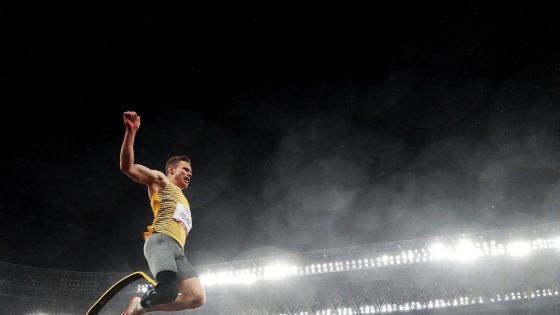Para badminton player Sukant Kadam (left), who will feature in his maiden Paralympics in Paris, chuckles when asked about his first classification experience.
âThereâs a funny story here. I was domestically classified as SL3 and played and perfected those rules. In 2014, when I went to England for my first international tournament, the classifiers there suddenly placed me in the SL4 bracket instead. That was a shock for me,â Kadam told Sportstar in the run-up to the Paris 2024 Games.
SL3 and SL4 are competing classes in para badminton for athletes with lower limb impairments. SL3 is for those with more severe levels of disability, requiring athletes to play on a half-width court. Kadam suffered a severe knee injury as a child, and multiple surgeries left him with impaired movement.
âSL4 meant I had to learn to play full court. There were such accomplished athletes already in this bracket, and I found myself having to deal with new space, new rules. I came in fully prepared for SL3 and its opponents, and I was so confident, but it was all taken away.
âI didnât play for two years. I was not prepared for that level of competition. It was in mid-2016 that I returned to an event in Ireland. I defeated the World No. 5 there and got my first international medal in my second international competition.â
READ |The Yogesh Kathuniya interview
Complaints from compatriots
Former Paralympic Committee of India president Deepa Malik also has numerous such classification ânightmaresâ that she now speaks about with a smile on her face.
A spinal tumour left her paralysed from the waist down, but Deepa found her calling in sports. Her journey began with swimming, but a lack of adequate facilities led her to switch to athletics.

Sukant Kadam.
| Photo Credit:
Special Arrangement
Sukant Kadam.
| Photo Credit:
Special Arrangement
In para athletics, track and jump events are denoted by the letter T, while field events take the letter F, followed by a numerical classification of disability class. Seated throws in javelin, shot put, discus, and club fall under the F51-58 bracket.
âI got classified in Taiwan in the F54 category in 2007. Two years later, I participated in the International Wheelchair and Amputee Sports Federationâs World Games in 2009 in India.
âI was competing in the javelin throw, but I was told that I was going to be disqualified as I didnât belong to that particular class. That was pretty heartbreaking. I had to go for re-evaluation when I found that my results were not on the final sheet.
âA medical protest had been raised about me not belonging to the F54 category. From there, I was surprised when they placed me in the F53 bracket, where the disability requirement was more severe.â
In her new category, javelin â in which Deepa had won a silver and two bronze medals at the Asiad â was not an option.
âI randomly picked shot put. I had played it in school, so I knew the technique. I wanted to at least get a participation certificate, as a disqualification would be pretty demeaning. I finished with a bronze medal from there.â
The 2010 Commonwealth Games came next, and it was the only year the F53 category was included in the roster.
Paris 2024 Paralympics, Opening Ceremony Highlights- In Pictures
âIt felt like a silver lining. I felt very dejected about how it all turned out. I have a severe spinal cord injury, and sometimes this is what happens in disability categorisation. More unfortunately, a lot of these protests came from my own compatriots,â she exclaimed.
âI had to undergo three more classification sessions. I would head to various competitions, and there would be a letter preceding my arrival.
âItâs agonising to go through this mentally and emotionally, as this brings a lot of uncertainty. Youâre going all the way, with so much time and money spent, and sometimes you might not even be able to compete.
âFortunately for me, after three such classification exercises, I was given a permanent confirmed class.â
Deepa went on to win silver in the shot put F53 bracket at the Rio Games.
READ |Paris 2024 Paralympics: Top 10 Indian medal prospects
Need for sports literacy
Ekta Bhyan, a club thrower in the F51 bracket, registered a seasonâs best effort of 20.12m to win gold in the womenâs F51 class at the World Para Athletics Championships in Kobe, Japan. However, by then she knew her bracket wouldnât be included in the Paris Games â a normal passage in Olympics/Paralympics where sports and classes get rotated in and out of the roster.
An accident that damaged her spinal cord left Ekta with complete paralysis of her lower limbs and partial paralysis of her upper limbs. She was classified in the F51 category, which is for athletes whose movement is highly affected in the trunk, legs, and hands, with low to moderate impairment affecting arm movement. She generates all the momentum she needs from her shoulders and hands.
While the Paralympics is an evolving canopy, Ekta believes that plenty of resources are available to athletes, coaches, and governing bodies to figure out their para sports plans.

Ruthless rules:Â âI would head to various competitions, and there would be a letter preceding my arrival. Itâs agonising to go through this mentally and emotionally, as this brings a lot of uncertaintyâ: Deepa Malik.
| Photo Credit:
Getty Images
Ruthless rules:Â âI would head to various competitions, and there would be a letter preceding my arrival. Itâs agonising to go through this mentally and emotionally, as this brings a lot of uncertaintyâ: Deepa Malik.
| Photo Credit:
Getty Images
âThe International Paralympic Committee (IPC) has a detailed guide on disabilities and their classification. For us, perhaps, the one issue is that this resource is in English. But lately, weâve seen that the Sports Authority of India is recruiting para athletes as coaches, and they know the drill. There are domestic classifiers, but to be eligible for international events, you need to be assessed by the IPCâs classifiers.â
The only area of concern she identifies is the potential difference between how athletes are classified domestically and what happens in international classifiers.
Ekta was witness to what happened with Vinod Kumar. At the 2021 Tokyo Paralympics, the para discus thrower threw an Asian record mark of 19.91m to secure a bronze medal in the menâs F52 class, adding to Indiaâs historic medal haul in a single edition.
However, within 24 hours, the former Border Security Force officerâs medal was stripped away after multiple complaints from competitors casting doubts over his î disability class. Then 41, Vinod was put under review by a classification panel, which later decided that he was ineligible to compete in the F52 class â a section where athletes compete in a seated position, either in a wheelchair or a throwing chair, due to impaired muscle power, restricted range of movement, limb deficiency, or leg length difference.
The Board of Appeal of Classification (BAC), an independent body, then banned him for intentionally misrepresenting his abilities in classification, suspending him from participation in para athletics for two years.
This isnât a rare occurrence. Athlete classification is the defining foundation of para sports, as thatâs where the playing field is levelled. There are instances where athletes are mistakenly classified into the wrong classes. This could happen because of a change in ability/function (improvement or decline) over time. There are times when athletes purposefully exaggerate their disabilities too. The latter has been decried heavily with each passing Paralympic cycle, likened to how immoral and unsportsmanlike doping is.
READ |Paris 2024 Paralympics: Top five Indian debutants
Evolving yet sacrosanct
At the heart of it all lies the process of classification itself and awareness among athletes and classifiers alike.
âItâs fairly common for young and new athletes to see back-and-forth with their classification, but it shouldnât be the case for established athletes who have competed in a bunch of major events,â Ekta added.
Manish Rana, Director of Sports Development and Performance with the PC!, underlines that classification from an administrative perspective is a diverse exercise. Disciplines like athletics and swimming have multiple subclasses, while others like powerlifting or judo have one or two classes.
âThere is a minimum impairment criterion, and classifiers look at underlying health conditions that lead to permanent disability, which then makes them eligible to play certain sports. For example, someone could lose a digit. That is technically a disability, but it doesnât mean they might qualify for para sports,â Rana said.
READ |Shooter Rudransh Khandelwal on his ambitions for Paris
Classifications can only be done in IPC-approved events, which is why Indians seek out Grand Prix events or World Championships to get this out of the way. It comes with massive costs, monetary and otherwise. The fact that nations only get a certain number of slots makes that process more competitive.
âWe have to make tough choices based on how many slots weâre allowed. Priority is given to î performance, people who are young and who we can groom for longer,â he added.
A workaround for this is to have an IPC-backed event in India.
âWe want to bring an IPC-approved Grand Prix to India around March or April next year. This is a calendar classification event and will be the first time India hosts it. Around October or November, we also want to host the Para Athletics World Championships. When we are the host country, we get more slots. If we get that approved, then this will be an event we will have every year.â

Grit hit:Â Ekta Bhyan, a club thrower in the F51 bracket, registered a seasonâs best effort of 20.12m to win gold in the womenâs F51 class at the World Para Athletics Championships in Kobe, Japan.
| Photo Credit:
Getty Images
Grit hit:Â Ekta Bhyan, a club thrower in the F51 bracket, registered a seasonâs best effort of 20.12m to win gold in the womenâs F51 class at the World Para Athletics Championships in Kobe, Japan.
| Photo Credit:
Getty Images
Athletes across the board explain that they need to move abroad to get internationally classified, but Rana clarifies that athletes can very well get qualified in their own countries, provided the classifier isnât of the same nationality.
Rana, a UK-certified Musculoskeletal Physiotherapist, has spent time at the IPC, training as a classifier in swimming, and understands the grey area para sports classification comes with.
âA lot of times, athletes arenât very aware of their classification. Amputees give us visual evidence of the body part that is missing, but with cerebral palsy or spinal cord injuries or visual impairments, the grey area becomes a bit larger. Itâs not about tools or tests being inadequate; it depends on assessing the disability on a case-by-case basis. The same condition can present different consequences for different people.
âItâs also important to remember that the sport itself is a massive leveller. Swimmingâs class system is point-based. The entire body is divided into points, and your class depends on how many points are deducted from 290. How those points get cut might be different for two athletes, but the athletes in a class are put at a similar disadvantage by the water,â he added. The need to be as foolproof as possible with classifications is also key in preventing malpractice, and the IPCâs new classification code seeks to address just that.
âNext year, a new edition of the classification code has been approved by the International Paralympic Committeeâs Annual General Body. Another criterion will be introduced.
âFirst, we went with meeting the minimum impairment criterion, but now athletes need to provide evidence for the underlying health condition thatâs causing the disability as well. It will help guard against malpractice in a better way,â Rana said.
Source Agencies





